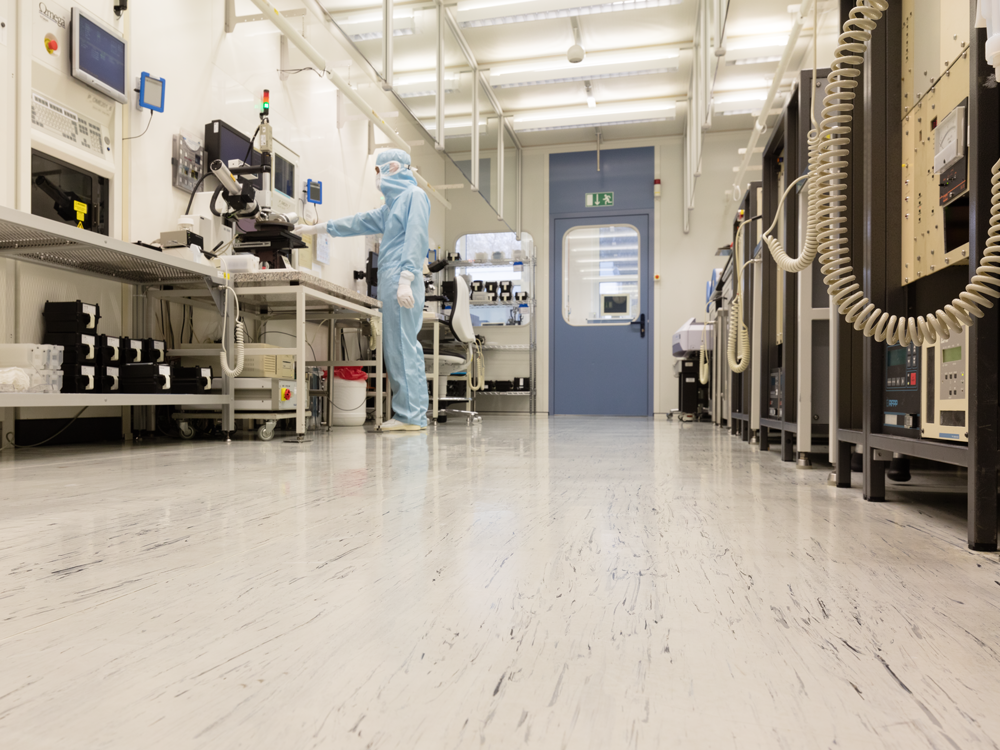Why Seitec Electronik GmbH has decided for the first time
on rubber floors as an alternative to epoxy resin and PVC
Electrostatically dissipative, resilient, easy to clean – the
requirements for floor coverings in electronics production
are extremely high. To ensure the quality and reliability of
electronic devices, their components must be protected
against electrostatic discharge (ESD) during production
and installation. Even discharges of as little as 100 V,
which are not noticeable to a human being, can damage
sensitive electronic components to such a degree that the
final product will not function properly. Although Seitec
Electronics GmbH had formerly always equipped its
production facility with electrostatically dissipative PVC
and epoxy resin flooring, for its new production hall the
company chose rubber for the first time – and it is very
satisfied with this decision.
Wanted: flooring for a new production facility
The company Seitec, founded in 1995, offers
comprehensive
solutions and integrated services in
the modern electronics field, from product development
to building automation, to light and infrared technologies.
In state-of-the-art production facilities in Elsteraue/
Saxony-Anhalt, Seitec produces prototypes for customers
from all over the world, as well as large product series.
Positive developments in the business have necessitated
several expansion projects over the years. The latest
new production facility, which contains final quality
inspection and packaging divisions in addition
to
a production
line for the assembly of printed circuit
boards, was opened at the end of 2016. “Rubber as
a flooring material for a production hall was at first
nowhere near being on our radar,” says Managing
Director Lutz Fichtler. On the recommendation of a
colleague
from university, who has been using
nora systems rubber flooring for many years, the
graduate
engineer decided to try out the Weinheim
manufacturer’s flooring systems. The floor coverings
he had previously used had left Fichtler not entirely
satisfied. “With PVC floors, we have difficulty removing
abrasions from fork lift wheels and spots from the
pressure
paste used to coat the unfinished circuit
boards before soldering. And with the coated epoxy
resin flooring installed in the warehouse, heavy pallets
have left unsightly scratches.”
Ten-year warranty on consistent ESD values
When it comes to the most suitable flooring for EPAs (Electrostatic Protected Areas), managers are often not
aware that there is an alternative to coated paving.
Flooring systems made of rubber have a low tendency
to charge due to their innate material properties and
do not need to be provided with a dissipative seal.
The advantage: conductivity is permanently retained.
This is an enormous advantage over other flooring
materials of which the coatings not only affect the reliability
of their conductive properties, but also require
regular replacement. The high and durable elasticity of
nora® flooring optimizes control points, i.e. the points
at which electrostatic charge is discharged into the
ground. In the case of hard, non-homogeneous flooring
materials, such conductivity is often not given.
Because as the plasticisers they contain can volatilize
over time, leaving the floor covering hard and
inflexible. “With PVC floors, the required dissipation
values no longer entirely match because of the coating,”
Fichtler continued. To renew the coating, the
production must be completely shut down during the
renovation. “This is a very complex process and can
only take place during the Christmas holidays.” The
fact that nora systems gives a ten-year warranty on
the electrostatic properties of its flooring has also
convinced Seitec.
...read more
Extreme Durability
Because of their extremely dense surface, floor systems
made of rubber are extremely resistant to wear and
can be used in areas with high pressure loads (up
to 6 N/mm²), such as those caused by fork lifts or
the wheels of heavy equipment and machinery. “Our
pallets, which we transport with fork lifts, can weigh as
much as 700 kilograms. That means the flooring must be extremely wear-resistant,” Fichtler explained. Due
to the elasticity of the homogeneous rubber material,
nora flooring also withstands impacts, for example
from falling tools, hose connectors, clamps, and other
metal parts. Likewise, falling objects will not be damaged,
or not so severely damaged, as they would by a fall
onto hard floors.
Good ergonomics and acoustics
Not the least of their benefits is that, due to their high
and durable elasticity, rubber floors also contribute to an ergonomic work environment for employees.
Particularly
for standing workstations, which are
common
in manufacturing halls, the substrate texture
plays an important part in promoting longer fatigue-free
working periods. Flooring systems made of rubber
make walking and standing easier thanks to their
durable
elasticity, which spares backs and joints.
Moreover,
the support this flooring offers reduces the
noise made when walking, which contributes to a quiet
and pleasant working environment. Because the discreet
tone-in-tone-granulation of the light gray noraplan® sentica ed fits well with both the new machines in the
production hall and the modern furniture in the cafeterua,
the flooring is also used there and underlines the
contemporary ambiance of the new building perfectly.

 Canada | English (US)
Canada | English (US)











